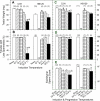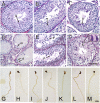Increasing testicular temperature by exposure to elevated ambient temperatures restores spermatogenesis in adult Utp14b (jsd) mutant (jsd) mice
- PMID: 25303716
- PMCID: PMC4391977
- DOI: 10.1111/andr.287
Increasing testicular temperature by exposure to elevated ambient temperatures restores spermatogenesis in adult Utp14b (jsd) mutant (jsd) mice
Abstract
Because mutations in the human UTP14C gene are associated with male infertility, we sought to develop a method for fertility restoration in azoospermic mice with a mutation in the orthologous Utp14b(jsd) (jsd) gene that have spermatogonial arrest. The method is based on our observation that elevation of testicular temperatures restores spermatogonial differentiation in jsd mutant mice. To non-surgically raise intrascrotal temperatures we placed these mice in incubators at different elevated ambient temperatures. Exposure of jsd/jsd mice to ambient temperatures of 34.5 °C or 35.5 °C for 24 days increased the proportion of tubules with spermatocytes from 0% in untreated controls to over 80%. As those higher temperatures interfere with spermatid differentiation, the mice were then transferred to incubators at 32-32.5 °C for the next 24 days. These environments allowed differentiation to progress, resulting in up to 42% of tubules having late spermatids and about half of the mutant mice having spermatozoa in testicular suspensions. When these spermatozoa were used in intracytoplasmic sperm injection, all gave rise to viable healthy offspring with normal weight gain and fertility. The successful restoration of fertility in Utp14b mutant mice suggests that transient testicular warming might also be useful for spermatogenesis recovery in infertile men with UTP14C gene mutations.
Keywords: azoospermia; genetic disorders; infertility; intracytoplasmic sperm injection; spermatogenesis.
© 2014 American Society of Andrology and European Academy of Andrology.
Figures



References
-
- Beamer WG, Cunliffe-Beamer TL, Shultz KL, Langley SH, Roderick TH. Juvenile spermatogonial depletion (jsd): A genetic defect of germ cell proliferations of male mice. Biol Reprod. 1988;38:899–908. - PubMed
-
- Bolden-Tiller OU, Chiarini-Garcia H, Poirier C, Alves-Feitas D, Weng CC, Shetty G, Meistrich ML. Genetic factors contributing to defective spermatogonial differentiation in juvenile spermatogonial depletion (Utp14b-jsd) mice. Biol Reprod. 2007;77:237–246. - PubMed
-
- Bradley J, Baltus A, Skaletsky H, Royce-Tolland M, Dewar K, Page DC. An X-to-autosome retrogene is required for spermatogenesis in mice. Nat Genet. 2004;36:872–876. - PubMed
-
- Brindley GS. Deep scrotal temperature and the effect on it of clothing, air temperature, activity, posture and paraplegia. Br J Urol. 1982;54:49–55. - PubMed
Publication types
MeSH terms
Grants and funding
LinkOut - more resources
Full Text Sources
Other Literature Sources
Research Materials

